
Canyoneering is an amazingly fun activity and a great way to get some rappelling in. I was curious about what the best device for rappelling was, though, so I did some research and came up with the following list.
According to my research, the best rappelling devices for canyoneering include:
- SQWUREL 2
- Canyonwerks CRITR 2
- Petzl PIRANA
- Sterling ATS Belay/Rappel Device
- Figure 8/ATC
Those are five strong candidates that will get you down any rappel that you need. As with anything, they each have their advantages and disadvantages, and a lot of the distinction between them is going to come down to personal preference. With that being said, however, I believe that the SQWUREL 2 is the best rappel device for canyoneering because of its innovative design and multiple levels of friction. The ‘tail’ feature on the device is a clever little addition that easily allows for more or less rope drag to be added, and the newly-improved nub allows for greater rope retention.
That’s not to say, however, that the SQWUREL is the right device for everyone. Depending on what you’re trying to get out of it, each device has its own advantages and disadvantages, which I go in to in more detail below. When all was said and done, this is what our research showed:
- Best All Around Canyoneering Device: The SQWUREL 2
- Runner Up: The Canyonwerks CRITR 2
- Best Budget Device / Most Bang For Your Buck: The Petzl PIRANA
- Best Device for Rappelling and Belaying: The Sterling ATS Rappel/Belay device
- Best for First Time / Infrequent Users: Black Diamond ATC or Figure 8
Below, I talk a little bit about why it’s useful to buy a device specifically for canyoneering, and then I go in to more detail about why I chose the devices that I did.
What is Canyoneering?
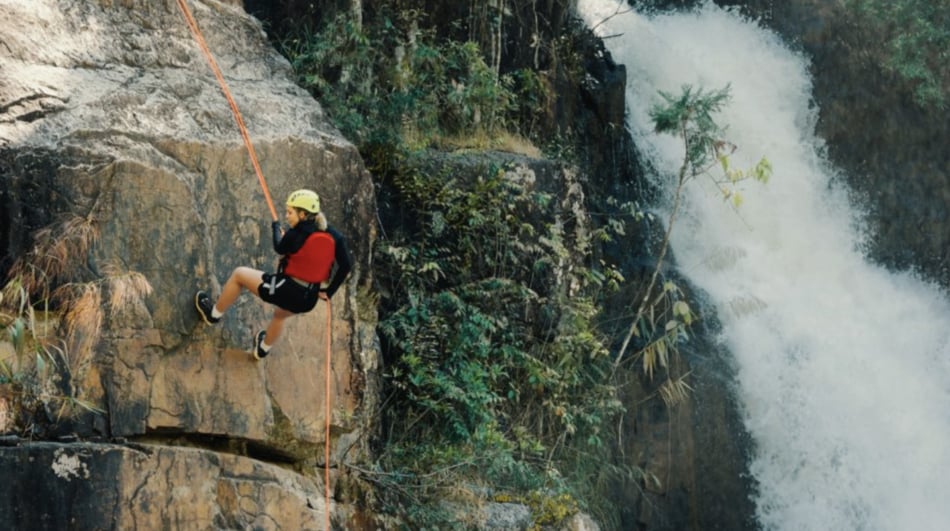
Before talking about what device to use, it’s important to understand what canyoneering is and what it entails. I talk about canyoneering a lot on this site, which makes sense because rappelling is such an important part of it.
Canyoneering is the act of travelling down a canyon using a variety of techniques like walking, scrambling, swimming, and rappelling. It can stretch from simple, two-hour trips that will only find you in water up to your knees, to full-day expeditions involving several technical sections and a lot of specialized gear.
Usually, you start at the top of a canyon, or somewhere where there’s an easy access point. You then follow the natural flow of the water down the canyon, splashing across pools, rappelling down cliffs, and generally testing yourself against the current of the water. Canyoneering is definitely a jack-of-all trades type sport; it requires strong swimming, and understanding of how rapids work, and solid climbing skills to see you through the more technical sections of the trip.
In terms of rappelling, canyoneering expeditions are where you’re going to find some of the most technical rappels out there. Waterfall rappels, over hanging rappels, tandem rappels, rappelling with a gear bag— you name it, and there’s a canyoneering trip where you’ll have to use it. Because of this, having the right gear for such a trip is essential.
Rappel Devices For Canyoneering
As I mentioned above, canyoneering is a great way to get out and have some fun in nature. It is, however, an inherently dangerous activity, and bringing the right kind of gear with you is paramount to ensure your safety. Because there are so many rappels involved in canyoneering, it makes sense to invest in a really solid device to help you increase your control on the rope.
Classic rappel devices, such as an ATC or a Figure 8, will work just fine (and we’ll get to them later). There are, however, some added complications to canyoneering that these all-around belay devices don’t handle as well as more specialized gear will.
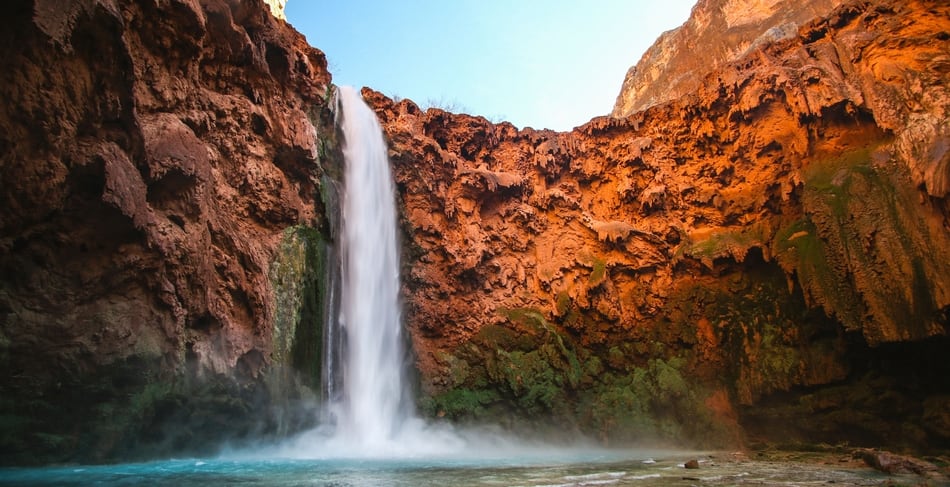
The major benefit of the more specialized devices is that many of them allow you to adjust the amount of friction mid-rappel. This is extremely useful in canyoneering, when you often have to do technical, demanding rappels in varying circumstances. Want to add friction to your device to get over an overhanging lip? The Piranha, ATS, CRITR 2, and SQWUREL will let you do that. Want to loosen up the rappel once you’re hanging freely so that you can get to the bottom of your rope quicker? Again, those devices have you covered.
There’s also the issue of rappelling with a wet rope. Especially at the end of a long day, when your hands are sore and cold, controlling the rappel when your gear is soaked can take a lot more effort. Having a device that allows you to add friction makes life so much easier.
So, with that in mind, let’s take a look at some of the more specialized devices that will make your canyoneering trip all the better.
Best All Around Device: The SQWUREL 2
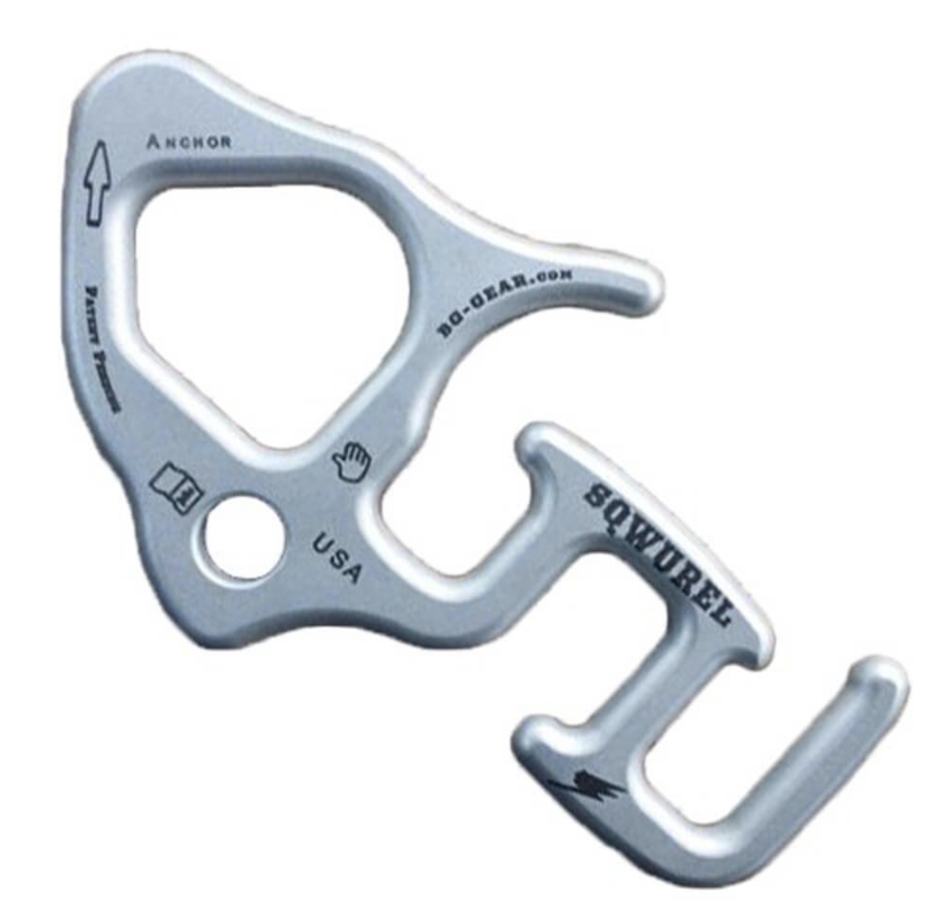
Price: $52.50 USD
You can buy it at: https://www.adventure.plus/shop/c/p/SQWUREL-2-x12765985.htm
Pros:
- Tail design allows for increasing/decreasing friction ‘on the fly’
- Improved rope retention nub allows for a shorter tail.
- Compact, narrow design reduces the chance of it catching on other pieces of equipment
Cons:
- More expensive than other devices
- Asymmetrical design can cause some difficulties for left-hand dominate canyoneers
Verdict:
This funky little device, named after its distinctive head and tail design, is the result of 3 years’ work and over 60 prototypes being built. The SQWUREL 2 is cleverly designed to allow for easy on-again, off-again adjustments to your friction levels via the ‘tail’ at the end, which allow you to simply slip the rope over it to add some stopping power to your belay.
The SQWUREL was built specifically for canyoneering, and it really shows. It’s not just the fact that it does everything the other devices do; it just does them better, and it requires less features to do so. In terms of rope control, no other device on this list can hold a candle to it. It’s got cleverly designed features, a streamlined look, and extra material in key friction areas. If used correctly, this device should last you well over 200 rappels— and that alone makes it worth the price tag.
The device isn’t perfect, however. The main flaw I could find through my research was that the SQWUREL’s asymmetric design made it harder to use for people who are left-hand dominant. In one instance, a fellow set it up incorrectly too many times and ended up prematurely wearing out his device.
Gear wear is never good, and if you start to notice a decline in the quality of your device you should definitely invest in a new one. When used correctly, however, the SQWUREL 2 has ever feature you could want in a canyoneering rappel device, and that makes it worthy of the #1 spot on this list.
Runner Up: The Canyonwerks CRITR 2
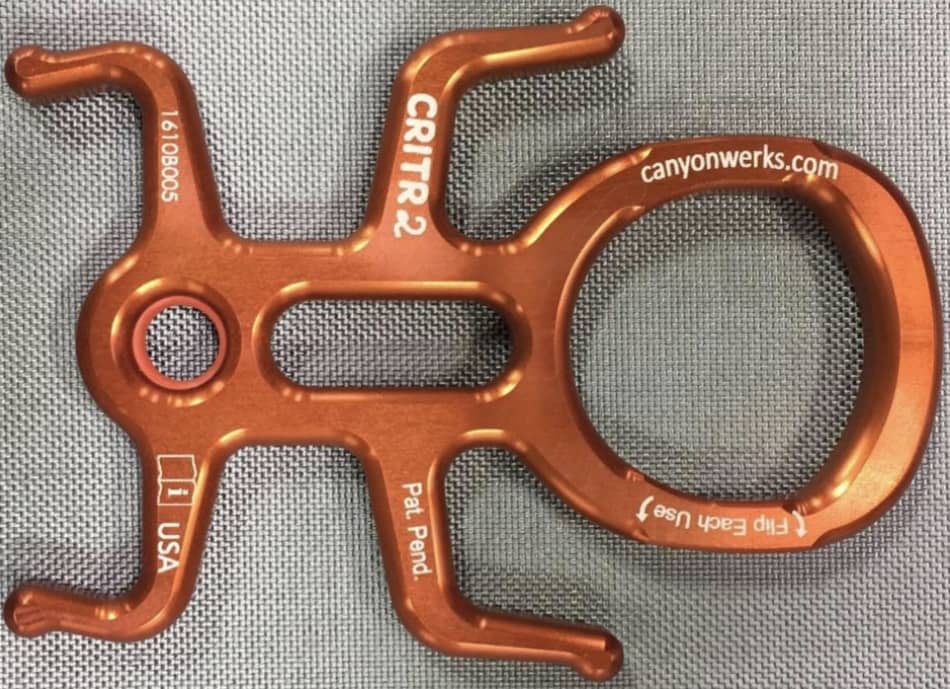
Price: $43.95
You can buy it at:https://www.adventure.plus/shop/Canyoneering/Technical-Hardware/Rappelling/p/Canyon-Werks-CRITR-2-Rappel-Device-x17404209.htm
Pros:
- Solid lock-off allows for resting mid-rappel
- Symmetrical design is simple, intuitive, and easy to use
- Wide, flat device reduces rope twist on the way down
Cons:
- Slightly more bulky than the SQWUREL
- Wider ropes may become jammed in the ‘legs’
Verdict:
Trying to chose between this device and the SQWUREL was a no win— or, I guess, a no lose— scenario. Both devices are awesome, with multiple friction levels, sturdy designs, and a slew of features designed specifically for canyoneering. The SQWUREL edged out the #1 spot because rappelling on it just feels so unbelievably smooth. That doesn’t mean, however, that the CRITR 2 isn’t a worthy device to get you down even the most technical of abseils.
Just looking at the device, you can tell that it’s built for dealing with technical terrain. Something about its design just screams sturdy to me. While it’s wide, flat body and protruding legs make it slightly more unwieldy than the SQWUREL, they also add a layer of longevity to the device. The CRITR is also reversible, so it allows for longer wear in sandy conditions. If you’re looking to save a few bucks, or if you just prefer the simplicity and sturdiness of the design over that of the SQWUREL, you can’t go wrong with the CRITR.
Best Bang For Your Buck: The Petzl PIRANA

Price: $39.95
Where to Buy: https://www.petzl.com/US/en/Sport/Belay-devices-and-descenders/PIRANA
Pros:
- Affordable price from a trusted manufacturer
- Smooth design allows for the PIRANA to be attached to the rope without needing to disconnect from your harness.
- Variable friction levels provide adequate adjustability pre-rappel
Cons:
- Fewer features than other devices
- Fewer friction levels can be added mid-rappel.
Verdict:
For those looking to save a little bit of money and still get some pretty decent functionality out of it, the Petzl PIRANA is a go-to rappelling device that was designed specifically with canyoneering in mind. Admittedly, it doesn’t have all of the features that the above two devices do, but it’s still got a lot going for it, and for 90% of people it’ll function just fine as a canyoneering device.
The main advantage in the PIRANA is that it allows you to set up your rappel without ever having to remove the device from your harness. This means there’s less chance of dropping it with your cold, water-clogged fingers once you’re five hours in to a canyoneering trip. Additionally, the PIRANA has three different friction levels that can be set before the rappel, and another two levels of variation you can adjust once the rope is weighted.
Six varying friction levels might not give you the same level of customization as the SQWUREL or the CRITR, but it’s nothing to scoff at either. The PIRANA also has a wide, flat design that reduces rope twist. While it may not be as technical of a device, it’s still designed by a world-class gear manufacturer with rappelling in mind, and that earns it a spot on the list.
Best Device For Belay/Rappel Combos: The Sterling ATS
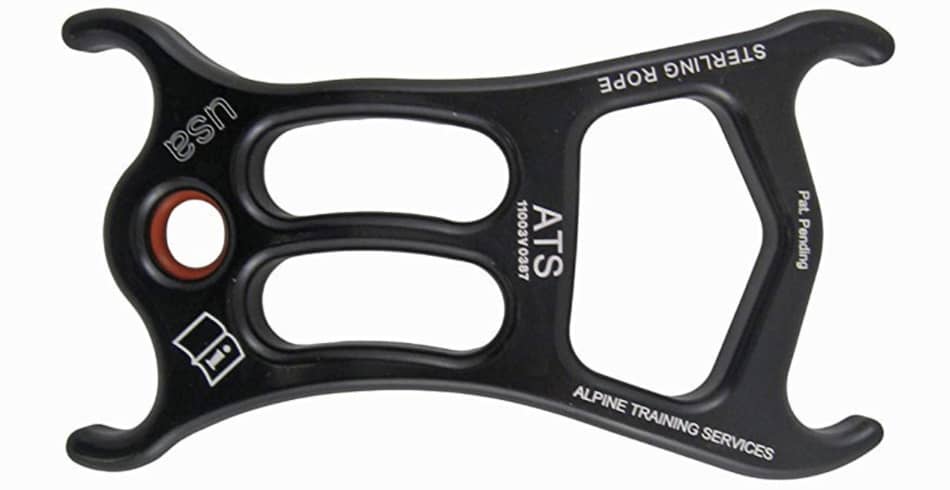
Price: $39.95
Where to Buy: https://www.amazon.com/Sterling-Rope-Device-Black-8-Inch/dp/B004MXCPRW/ref=cm_cr_arp_d_product_top?ie=UTF8
Pros:
- Two-slot design allows for easy double-rope rappelling
- Middle slot also allows the device to be used for belays
- Four horns give varying friction levels mid-rappel
Cons
- Smaller carabiner hole only fits specialized equipment.
- Generalist design lacks some of the features of the above devices
- Soft metal wears quickly when faced with sand and water
The Sterling ATS is an all-around rappel/belay device that combines a traditional tube design with the features of the CRITR and other canyoneering devices. While the ATS is a solid device that can take you from the canyons of Utah to the alpine meadows of Colorado, it lacks some of the down-to-earth functionality that the more specialized devices boast.
The ATS allows you to belay and rappel, and it will do both of those things perfectly fine— but it isn’t particularly great at either one of them. As a belay device, it’s a little too big and bulky to excuse bringing it on fast-and-light alpine expeditions. As a canyoneering device, it lacks the control and specialized ability that the CRITR and SQWUREL do. Sure, the four horns work fine, and the concave/convex nature allow you to adjust for friction pre-rappel, but we found that the ATS didn’t quite have the same amount of control as the other three did when doing more technical rappels.
That being said, it’s still an awesome device, and for most people going in to a canyon, it’ll serve you just fine. If you’re also a fan of climbing and you want to get some days in at the crag, the ATS will allow you to do so without needing to go out a purchase another device. It also does have the advantage of offering easy-to-perform two rope rappels, which is never a bad thing in my books. These features, however, just aren’t quite enough to outweigh its disadvantages.
Easiest to Use / Best for First-Time Canyoneers: The Black Diamond ATC and Figure 8
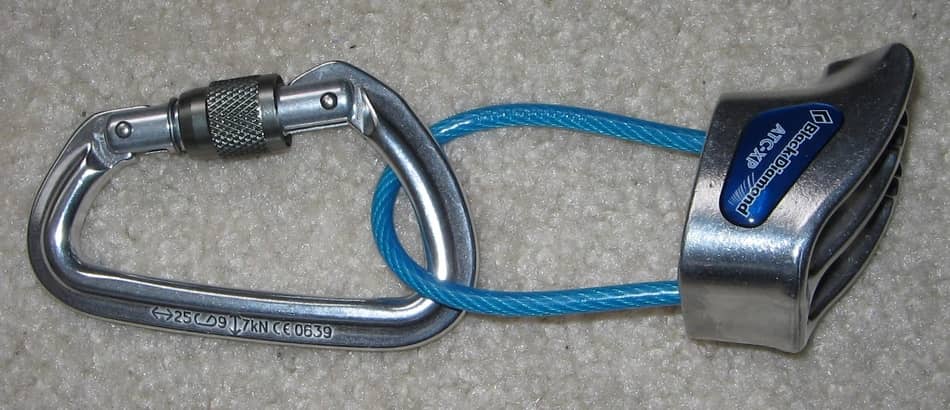
Price: $25.95/15.95
Where to buy: https://www.blackdiamondequipment.com/en_CA/search?cgid=belay-rappel
Pros:
- Simple, easy to use, intuitive design
- Familiar to many climbers
- Rugged, all around devices
Cons:
- No adjustability mid-rappel
- Higher chance of rope twist
- Less control
Anyone who reads my blog knows that I absolutely love the Black Diamond ATC. It is, in my opinion, the best rappel device on the market: it’s small, it’s easy to use, you can use it with one or two ropes, it’s rugged as hell… the list goes on and how. However, despite how much I love the thing, even I’m inclined to admit that, in terms of canyoneering devices, it’s far from the best device on the market.
To start, it doesn’t allow you to adjust your friction mid rappel. In fact, it doesn’t really allow you to adjust your friction at all. You cant try, using a carabiner-prussik set up, but doings so takes up time that could otherwise be spent canyoneering. Additionally, the ATC (and the classic figure 8) just don’t have the same range of features as the above devices.
That being said, for most people embarking on a canyoneering trip, these two devices will work perfectly fine, especially if you’re doing something that’s not too technical. Almost every climber I know has an ATC or a Figure 8 somewhere in their gear shed. If you want to head out to the canyons for a day and don’t want to have to invest in an entirely new device, your ATC/Figure 8 will serve you just fine.
Conclusion
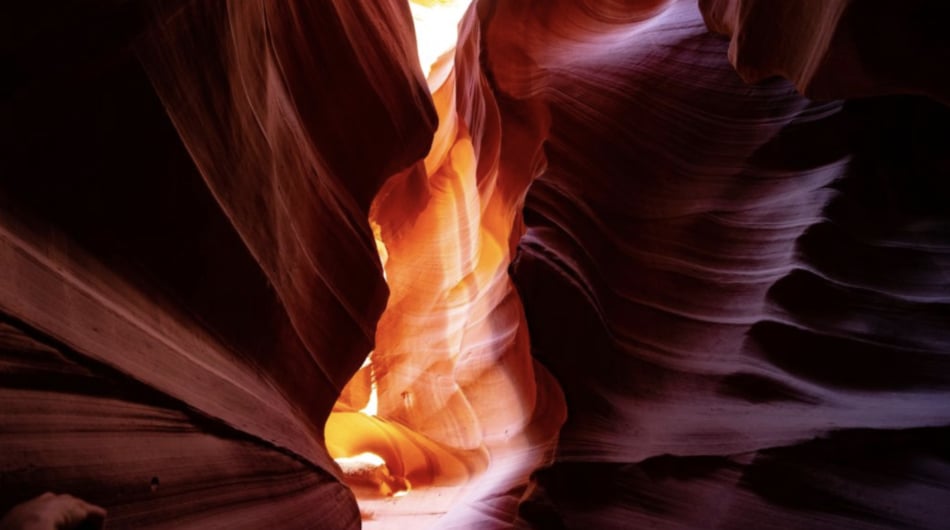
So there we go! Out of the above list, there’s really no way to go wrong in terms of what device you chose to buy. All of them are incredibly well designed and backed by trusted manufacturers who know what they’re doing.
Still, canyoneering is a tricky sport, so make sure you do your research and buy the device that feels right for you. Don’t take my word for it, either; go out to your local MEC or REI and try these devices for yourself. Practice a couple of rappels in controlled conditions, seeing how you like the different features of each device, and really get a feel for them before you make a buying decision. On top of that, remember to always be safe out there, and don’t go on a trip until you’ve got the proper skills and planning to get home safely!
Related Questions
Where Can I Buy A Steel Rappel Device? Steel devices are great because they’re virtually impossible to wear down. While they might not have the same lightweight advantages that other metals do, they’ll last you for a lifetime and you won’t have to worry about them wearing in. The ProClimbing Big 8 is a stainless steel rappel device available on Amazon that actually has a lot of canyoneering-friendly features!
What’s the Best Rappel Device? The title for best rappel device is a hotly contested one. As I’ve said in the article, my personal favourite is the Black Diamond ATC. Not everyone agrees with me, however, and there’s lots of other choices out there that will serve you just as well. I’m working on a complete guide to finding thee best rappel device as we speak, so stay tuned!
